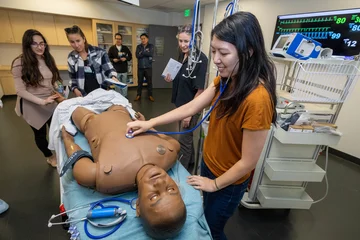Choosing a Future Career Path: Studying Law or Medicine
As college graduation comes into view, it's a question many college students think about: med school vs. law school. And although they're very different professions, both types of schools attract those who seek rigorous intellectual stimulation and personal satisfaction of helping the community.
How do you decide whether to apply to medical school vs. law school? Here are some comparisons:
How Competitive Are They?
There are 172 medical schools in the United States granting medical doctor (MD) and doctor of osteopathy (DO) degrees, though schools are still being added given the demand for more primary-care doctors nationwide. In 2015, there were 52,550 applicants to medical schools affiliated with the American Association of Medical Schools (which includes 145 U.S. schools granting a med degree and 17 Canadian schools, but not including osteopathic schools). While acceptance rates were not available, 20,630 of these applicants enrolled in medical school.
There are 203 law schools in the United States. Just two years ago, reports the Law School Administration Council (LSAC), there were 53,306 law-school applicants from the United States who pursued American Bar Association-approved law schools (with a few thousand more applicants from foreign countries), and 41,592 students were accepted.
How You're Learning
Which is more rigorous, medical school vs. law school? It depends on one's strengths. Law school relies more on reading, writing and classroom time. Professors don't lecture so much as they engage their students in reciting case facts and applying legal principles on the spot.
In med school, students start off building a solid foundation in science, moving on to clinical knowledge through problem-based learning. There's a great deal of memorization with respect to medical terms, body systems and diseases — plus some lab work. Years three and four take place in the hospital performing clinical rotations, instead of the classroom.
Time to Degree
Law school is typically a three-year program, with summers spent working in a legal environment. Many law students try to secure summer associate positions at law firms to better position themselves for future employment.
Med school is usually a four-year course of study. Between the first and second years students generally have a few months off, during which time they can do research, work or travel. The other two medical-school summer breaks are shorter, often four to six weeks, and students may use the time to study or prepare for their residency interviews.
Time to Practice
Having finished law school, law students take the bar exam in the state where they intend to work. Once they pass the bar they can officially practice, and positions are often contingent on passing the exam within a certain time frame.
Medical students finish the four-year school program and then enter residency, the length of which depends on the specialty, according to the American Medical Association (AMA). Residencies range from three to seven years, with optional one- to three-year fellowships afterward. The physician becomes licensed to practice medicine during residency and receives a starting salary at this time.
Deciding on med school vs. law school is a big decision, with very different outcomes of employment down the road. It's helpful to talk to current students in both fields to hear about their experiences, as well as recent graduates who can provide an inside perspective.




